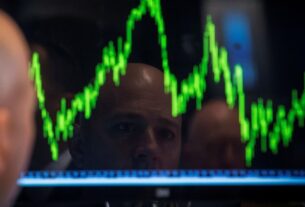Investors plowed more than $1 trillion into U.S.-based exchange-traded funds in 2024, shattering the previous record set three years ago and raising Wall Street hopes for an even bigger year ahead.
The rebound from last year’s lackluster flows marked a broad embrace of U.S. assets in a year in which the S&P 500 gained around 25%, analysts said. Longer-term trends also played a role as investors extended a yearslong practice of swapping their mutual funds for the greater tax advantages and easy trading of ETFs.
Total assets in U.S.-based ETFs reached a record $10.6 trillion at the end of November, according to monthly ETFGI data, an increase of more than 30% from the start of 2024.
View Full Image
“Investors clearly had their confidence back this year,” said Brian Hartigan, Invesco’s head of ETFs and index investments. “The mood was risk-on.”
Swelling ETF assets were a windfall for Wall Street giants including BlackRock, which reported record management fees this year. Its stock reached record highs. It was also a big year for smaller asset managers that specialize in actively managed ETF strategies.
The biggest S&P 500 funds led the inflow leaderboard as usual. Invesco’s QQQ, which tracks the tech-heavy Nasdaq-100 Index, followed, attracting more than $27 billion of fresh cash through mid-December. It was an eye-popping figure after QQQ brought in $7.3 billion in 2023, said Hartigan.
Investors looked especially optimistic in the weeks after Donald Trump was elected president, putting a monthly record of $164 billion into ETFs in November. Many are hoping lower taxes and fewer regulations can stoke an already-hot stock market during Trump’s second term.
Fixed-income ETFs, which make up a smaller share of the market than equity funds, also had a strong year. They benefited as investors tried to lock in elevated yields as the Federal Reserve began to cut short-term rates.
While flows to stock funds were well over double those to their fixed-income counterparts through the end of November, bond funds grew at a faster pace relative to their starting assets. This year’s influx represented almost 20% of total assets under management at the start of the year.
But as the fourth quarter rolled on, it was clear that U.S. equities remained king. The rolling three-month differential between flows to U.S. stock funds and all other types of ETFs reached a record high in November, according to the research team at SPDR, State Street’s ETF business.
Funds that buy U.S. stocks dominated, dwarfing the fund flows to international stocks. In November, 97% of net inflows to stock funds went to the U.S.
“There’s a lot of exuberance and excitement over this idea of U.S. exceptionalism in terms of economic growth and profit and performance,” said Matthew Bartolini, head of SPDR Americas research.
Investors chased performance with their money this year, and there is a growing risk that they have become overly concentrated in such areas as big tech and U.S. large-caps, Bartolini said.
Another growth area: active management. While ETFs have long been associated with passive, index-tracking stock investing, more-complex, options-based strategies exploded this year, as did bitcoin funds.
When more than a dozen asset managers got the regulatory go-ahead in January 2024 to launch the first U.S. funds that could buy and offer direct exposure to bitcoin, the cryptocurrency began a sharp rally. Investors plowed billions into the funds, minting several of the most successful ETF launches in history.
At the other end of the risk spectrum, retirees looking to maintain stock exposure while cutting some of their risk flocked to a class of funds that the industry is colloquially calling “boomer candy.” The actively managed funds typically use an options-based strategy to damp volatility and generate income for shareholders.
ETFs are also no longer a predominantly passive vehicle: Active funds took in roughly 30% of all fund flows this year through November. That is welcome news for fund managers, who have watched assets swell in recent years but have had to contend with a race to the bottom on management fees.
“Our average fee has gone up actually because of the assets in active,” said David Mann, head of ETF product and capital markets at Franklin Templeton.
Write to Jack Pitcher at [email protected]




